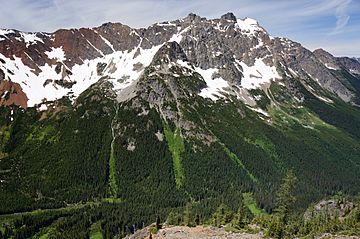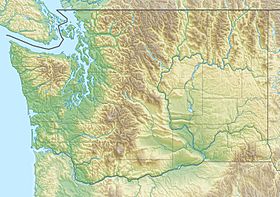Mount Ballard (Washington) facts for kids
Quick facts for kids Mount Ballard |
|
|---|---|

Mount Ballard seen from PCT at Grasshopper Pass
|
|
| Highest point | |
| Elevation | 8,340 ft (2,540 m) |
| Prominence | 780 ft (240 m) |
| Isolation | 2.02 mi (3.25 km) |
| Parent peak | Azurite Peak (8,420 ft) |
| Geography | |
| Location | Whatcom County Washington, U.S. |
| Parent range | North Cascades |
| Topo map | USGS Azurite Peak |
| Climbing | |
| Easiest route | class 3 scrambling |
Mount Ballard is a tall mountain in Whatcom County, Washington. It stands about 8,340 feet (2,542 meters) high. This makes it one of the highest peaks in Washington state.
Mount Ballard is part of the Okanogan Range. This range is a smaller part of the larger North Cascades mountain system. The mountain is located in the Okanogan National Forest. It is the 88th highest peak in Washington.
The closest taller mountain is Azurite Peak. It is about 2 miles (3.2 kilometers) south of Mount Ballard. Water from Mount Ballard flows into Mill Creek and Slate Creek. These creeks then join the Skagit River.
Mountain Weather
Mount Ballard is in a special climate zone. This zone is called the marine west coast climate. It is found in western North America. Most of the weather systems here start over the Pacific Ocean. They then move northeast towards the Cascade Range.
As these weather systems reach the North Cascades, they are pushed up by the mountains. This causes them to drop their moisture. This moisture falls as rain or snowfall on the Cascades. This process is called orographic lift. Because of this, the western side of the North Cascades gets a lot of rain and snow. This is especially true during winter.
In winter, the weather is often cloudy. But in summer, high-pressure systems over the Pacific Ocean bring clear skies. This means there is often little or no cloud cover. Because of the ocean's influence, the snow tends to be wet and heavy. This can create a high risk of avalanches.
How the Mountains Formed
The North Cascades mountains have very rugged shapes. You can see jagged peaks, tall spires, sharp ridges, and deep valleys carved by glaciers. These different shapes and big changes in height were created by geological events. These events happened millions of years ago. They also led to the different climates across the Cascade Range.
The Cascade Mountains started to form millions of years ago. This was during the late Eocene Epoch. At that time, the North American Plate was slowly moving over the Pacific Plate. This movement caused many volcanic eruptions.
Also, small pieces of the Earth's crust, called terranes, came together. These pieces were from both the ocean floor and continents. They helped create the North Cascades about 50 million years ago.
During the Pleistocene period, which was over two million years ago, glaciers played a big role. These huge ice sheets moved forward and backward many times. As they moved, they scraped the land. They left behind piles of rock debris. The "U" shape of river valleys today is a result of these glaciers.
The main forces that created the tall peaks and deep valleys of the North Cascades are uplift and faulting. Uplift is when the Earth's crust pushes upwards. Faulting is when cracks form in the Earth's crust and sections move. These processes, combined with glaciation, shaped the landscape we see today.



